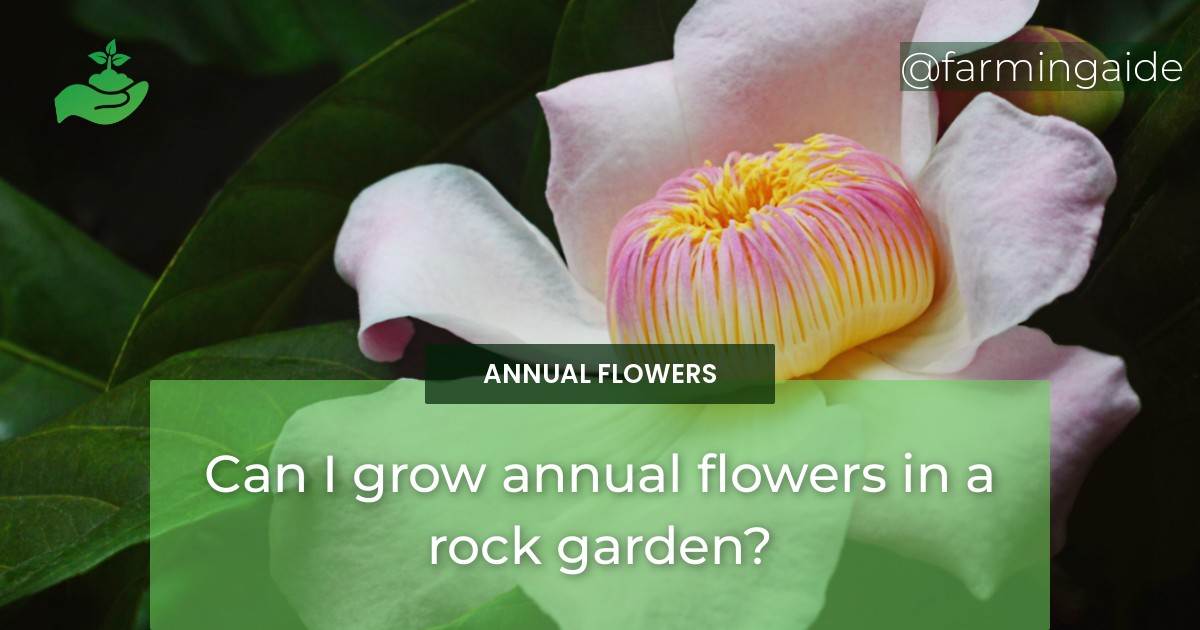Yes, you can grow annual flowers in a rock garden. In fact, rock gardens can be an excellent location for annual flowers. Annual flowers provide a burst of color and can be used to fill in spaces between rocks, soften edges, and add texture and interest to a rock garden.
Would Annual Flowers Thrive Alongside Vegetables in a Rock Garden Setting?
Yes, growing flowers with vegetables can enhance a rock garden setting. Annual flowers like marigolds, petunias, and zinnias can add color and attract pollinators. They help create a visually appealing and productive space. Plus, they can serve as natural pest deterrents for your vegetable plants.
Tips for Growing Annual Flowers in Rock Gardens
Choosing the Right Types of Annual Flowers
When selecting annual flowers for your rock garden, it’s important to choose varieties that are suited to the growing conditions in your area. Some annuals are better suited to full sun, while others prefer partial shade. Consider the amount of sunlight your rock garden receives at different times of the day when selecting your plants.
Examples of Suitable Annual Flowers
Some annual flowers that are well-suited to growing in rock gardens include:
- Portulaca
- Alyssum
- Petunias
- Marigolds
- Zinnias
- Verbena
Factors to Consider When Choosing Varieties
When selecting annual flowers for your rock garden, consider the size of the plants, the color of the flowers, and the length of the blooming period. It’s also important to choose plants that have a similar growth habit to prevent overcrowding and competition for resources.
Soil Preparation for Annual Flowers in Rock Gardens
Before planting annual flowers in your rock garden, it’s important to prepare the soil. Proper soil preparation will help ensure that your plants thrive and produce healthy blooms.
Testing the Soil
Start by testing the soil in your rock garden to determine its pH level and nutrient content. This will help you identify any deficiencies or imbalances that need to be addressed before planting.
Soil Amendment Techniques
Once you know the nutrient content of your soil, you can amend it as needed to create an optimal growing environment for your annual flowers. Some common soil amendments include compost, peat moss, and perlite.
Timing for Soil Preparation
The best time to prepare the soil in your rock garden is in the spring or fall before planting. This will give the amendments time to integrate into the soil and improve its structure and nutrient content.
Rock Placement for Annual Flowers in Rock Gardens
The placement of rocks in your rock garden can have a significant impact on the health and growth of your annual flowers. Proper rock placement can help improve drainage, retain moisture, and create a visually appealing landscape.
Selecting the Proper Rocks
Choose rocks that are similar in size and shape to create a natural-looking rock garden. Avoid placing rocks too close together or too far apart, which can create drainage problems and affect plant growth.
Proper Placement Techniques
When placing rocks in your garden, bury a portion of each rock in the soil to prevent shifting and improve stability. Create small pockets of soil between the rocks to plant your annual flowers.
Enhancing Drainage and Retaining Moisture
Place rocks in a way that helps retain moisture and improve drainage. For example, placing rocks at the base of a slope can help prevent erosion and improve water retention.
Tips for Planting and Maintaining Annual Flowers in Rock Gardens
Once you’ve prepared your soil and placed your rocks, it’s time to start planting your annual flowers. Here are some tips for planting and maintaining your plants:
Planting Techniques
When planting annual flowers in your rock garden, dig small holes in the soil pockets between the rocks. Plant your flowers at the same level they were growing in their container.
Watering and Fertilization
Water your annual flowers regularly, especially during hot and dry weather. Fertilize your plants every two to three weeks with a balanced fertilizer to promote healthy growth and blooming.
Deadheading and Pruning
Remove spent blooms regularly to encourage new growth and prolong the blooming period. Prune your plants as needed to maintain their shape and prevent overcrowding.
Common Challenges in Growing Annual Flowers in Rock Gardens
While rock gardens can be an excellent location for annual flowers, there are some common challenges that you may encounter:
Pest and Disease Control
Rock gardens can attract pests such as slugs and snails. Monitor your plants regularly and use natural pest control methods such as beer traps and copper tape to keep them at bay.
Temperature and Weather Considerations
Rock gardens can be affected by extreme temperatures and weather conditions, such as frost and heavy rain. Protect your plants from frost by covering them with blankets or frost cloth. Provide extra water during periods of drought or high temperatures.
Soil and Drainage Issues
If your rock garden has poor drainage or soil quality, your annual flowers may struggle to thrive. Consider adding soil amendments or creating drainage channels to improve the growing environment.
Advantages of Growing Annual Flowers in Rock Gardens
Despite the common challenges, growing annual flowers in rock gardens has many advantages:
Aesthetics and Visual Appeal
Rock gardens add texture and depth to your landscape, and annual flowers can provide a burst of color and interest.
Low-Maintenance Gardening
Rock gardens require minimal maintenance once established, making them an ideal choice for busy gardeners or those with limited time for gardening.
Drought-Tolerant and Hardy Plants
Many annual flowers are drought-tolerant and can thrive in hot and dry conditions, making them a smart choice for rock gardens in arid regions.
Conclusion
Annual flowers can thrive in rock gardens with proper soil preparation, rock placement, and maintenance. By selecting suitable varieties of annual flowers, preparing the soil, and placing rocks strategically, you can create a visually appealing and low-maintenance garden that is sure to impress.


